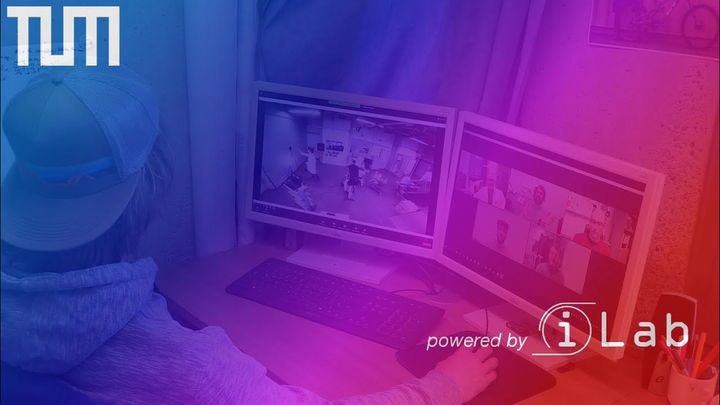iLAB – Interactive Synthesis of Exercise Biology and Performance Analysis
A virtual student project close to reality!
The applicants:
- Dr. Martin Schönfelder (Professur für Sportbiologie)
- Dr. Fabian Stöcker (Lehr- und Lernlabor)
- Dr. Peter Spitzenpfeil (Angewandte Sportwissenschaft)
- Prof. Dr. Henning Wackerhage (Professur für Sportbiologie)
A virtual student project close to reality!
The COVID-19 pandemic has presented faculty and students alike with significant teaching challenges. At the same time, this resulted in several new opportunities. For example, lecturers were forced to convert the very practical module content to online teaching. But with the help of instructional videos and various forms of online teaching, it has thus has become been possible to manage thedemonstrate and teach teaching of scientific methods quite welldetailed and consistent, even with benefits for upcoming semesters. Nevertheless, in many areas this does not replace practical "hands-on" work in the laboratory in many areas. In particular, activities that require special technical skills, such as pipetting in a bio-chemical the wet lab or blood collection for lactate analysis, are difficult to visualize and to train in this way. Furthermore, pre-recorded podcasts are very difficult to use for interaction between the people involved and the audience or the laboratory infrastructure.
Via combination of the already proven modern online platforms (e.g. Moodle, Matlab, Scinote, and more) with the specific streaming stations (custom-made hardware to screen the different lab situations) the idea of the so-called “iLab” will be formedwas born.
A virtual student project close to reality!
The iLab consists of several video production-sets for to capture different lab situations. These range from classical sport scientific investigations to biochemical analyses in the wet biological lab. Here, the main focus is on generating video sequences filming of different lab situations for live-broadcasting or for podcast-production. For this the teacher´s point of view will be combined with different wide wide-angle cameras. This ensures a very realistic image of the lab as well as of the lab work.
A virtual student project close to reality!
On the one hand the iLab will be used for method teaching. Thus, via detailed podcasts as well as live-filming sessions and broadcasting the different methods, may it be performance physiological or molecular biological tests, can be realistic, very close and step-by-step pictured. In this way the students should get the feeling to be part of live-sessions and that they are able to interactvene, even when they are not on site. This is the main focus of the iLab. Screencasts of the used applied software, which arewill be parallelly broadcasted to the other cameras, the scene will complete the scenebe completed. Furthermore, the students will have access to the specific software via server based virtual machines. With those, it will be possible to post process the prior measured data. Extra online discussions (e.g. via zoom) will complete the setup. In this way, it is possible to show more exemplary data (e.g. of subjects with different characteristics during performance physiological tests) or more histological pictures. In comparison to the classical teaching setup, those extra data and images can then be processed and discussed.
A virtual student project close to reality!
Besides the already mentioned use cases, iLab will be an extendsion of the regular and presence-based teaching methods. The presence teaching can start on higher knowledge-level becauseDue to the circumstance, that the students can learn the basics (e.g. calibration of measurement equipment and software, security instructions etc.) via podcasts prior to lab visits., the presence teaching can start on a higher level regarding the knowledge. Therefore, more time in the lab is left available for the hands-on application of several methods in the lab.
Furthermore, the interaction in the virtual lab is a central point of iLab. Within this setup, the students will be able to conduct experiments on their own. For this oOne or more colleagues will function as “virtual lab-assistants” or as “virtual probands”. During the live-sessions sStudents are now capable to telecommand the persons in the lab from wherever they are and to see the results liveduring the live-sessions. Moreover, if the students get stuck and do not know how to proceedgo on with the experiment, they can ask for help and advice by one of the lecturers. In this way the so important “trial-and-error-principle” can also be applied within the online teaching.
A virtual student project close to reality!
During the third term in the master´s program Sport and Exercise Science the students have to work on a research question. TIn subgroups, they have to plan the experiment in subgroups, conduct it and gather the data and to evaluate itfor processing and evaluation. Furthermore, they have to present their results in from of individual talks and group poster presentations during a symposium-like event. This project constitutes as the combination of the biochemical lab methods and the performance physiological measurements, which are already learned in the second semester. Due to the fact that both parts (biochemical methods as well as performance physiological tests) take place on the same time but in different rooms, the students are not able to conduct all methods personally. iLab breaks down the physical walls between lab-spaces and enables transfer of experience even across different lab-environments. Thus, projects groups will merge together, even when they work on different issues in different roomsBut with the help of iLab students, which are in the wet lab conducting the biochemical analysis, can at the same time take part in the performance tests via virtual live-sessions (and vice versa). And in this way a knowledge transfer is possible.
